Indonesia is an island nation between Australia and southeast Asia, and the Pacific Ocean to the east and Indian to the west. It counts over 17,504 islands, of which about 6,000 are inhabited, including the larger ones Sumatra, Sulawesi, Java, and some of Borneo and New Guinea. Its population is over 270 million, making Indonesia the most populous Muslim-majority nation on the planet. The name is from Greek (aren’t they all?), indos (India) + nesos (island), coined by ethnologist James Logan.
Indonesia is the site of some of the oldest hominid fossils on earth: “Java Man”, indicating the area was inhabited between 2 – 0.5 million years ago. Humans arrived roughly 43,000 years ago. Later Austronesian migrants drove the prior inhabitants out around 2000 BCE and make up the dominant modern ethnicity. The Dutch colonized the area in the 1600’s, but were driven out by the Japanese in World War II. In 1945 Indonesia proclaimed its independence, and has veered between democracy and authoritarian government ever since.
Islands in the volcanic Indonesian archipelago.
The Pura Bratan Hindu temple, Bali.
The nation’s thousands of islands stretch 5,120 km/3,181 mi E-W and 1,760 km/1,094 mi N-S. It spans the equator and sits across the link between Pacific and Indian Oceans. The region is very active volcanically, including, most recently, Mount Semeru in Java (Dec. 6, 2021). The current island were once part of a large land bridge when ocean levels were lower during the last glaciation, which is how early migrants passed through and settled the area. The area was drowned with the melting of the glaciers and became the current archipelago.
Köppen-Geiger climate map of Indonesia.
Indonesian Throughflow.
Due to its tropical climate and densely inhabited forests, Indonesia is home to some of the world’s greatest biodiversity both on land and in the water, and contains nearly a third of the world’s coral reefs. Water tends to move from the slightly higher Pacific westward to the Indian Ocean, in a set of currents known as the Indonesian Throughflow. Its total transport is 12.5 Sverdrups, or 12.5 million square meters per second (for comparison, the volume transport of the Gulf Stream off the southeastern US is 30 Sv, about 2.4 times as much).
Tomorrow: the coral reefs of Indonesia.
Be brave, and be well.










No comments:
Post a Comment